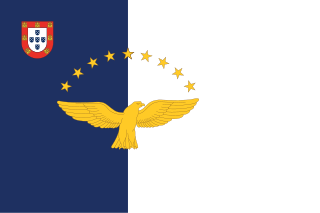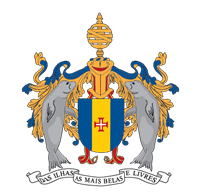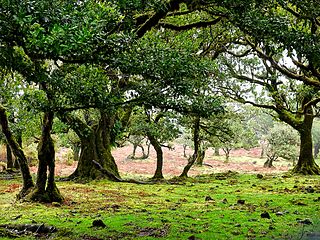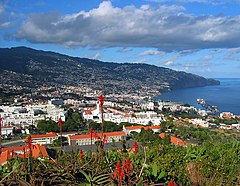
The Azores, officially the Autonomous Region of the Azores, is one of the two autonomous regions of Portugal. It is an archipelago composed of nine volcanic islands in the Macaronesia region of the North Atlantic Ocean, about 1,400 km (870 mi) west of Lisbon, about 1,500 km (930 mi) northwest of Morocco, and about 1,930 km (1,200 mi) southeast of Newfoundland, Canada.

Madeira, officially the Autonomous Region of Madeira, is one of two autonomous regions of Portugal, the other being the Azores. It is an archipelago situated in the North Atlantic Ocean, in a region known as Macaronesia, just under 400 kilometres (250 mi) to the north of the Canary Islands and 520 kilometres (320 mi) west of the Kingdom of Morocco. Madeira is geologically located on the African Tectonic Plate, although it is culturally, politically and ethnically associated with Europe, with its population predominantly descended from original Portuguese settlers. Its population was 251,060 in 2021. The capital of Madeira is Funchal, which is located on the main island's south coast.

Portugal is a unitary state with delegated authority to three levels of local government that cover the entire country:

Porto Santo Island is a Portuguese island 43 kilometres (27 mi) northeast of Madeira Island in the North Atlantic Ocean; it is the northernmost and easternmost island of the archipelago of Madeira, located in the Atlantic Ocean west of Europe and Africa.
The Madeira Football Association is the regional governing body for the all football competitions in the former Portuguese district of Funchal, including both Madeira Island and Porto Santo Island. It is also the regulator of the clubs registered in the autonomous region.

Santa Maria is an island in the eastern group of the Azores archipelago and the southernmost island in the Azores. The island is known for its white sand beaches, distinctive chimneys, and dry warm weather.

Machico is a municipality, parish and city in the southeast part of the island of Madeira, in the Autonomous Region of Madeira. The easternmost municipality on the island, it is also the third-most populous area with a population of 21,828 in 2011. The town, proper, had a population of 10,894 in 2001.

Porto Moniz is a municipality in the northwest corner of the island of Madeira. It is located west of Santana and Machico, and northwest of Funchal. The population in 2011 was 2,711, in an area of 82.93 km2.

João Gonçalves Zarco is a Portuguese explorer who established settlements and recognition of the Madeira Islands, and was appointed first captain of Funchal by Henry the Navigator.
Tristão Vaz Teixeira was a Portuguese navigator and explorer who, together with João Gonçalves Zarco and Bartolomeu Perestrelo, was the official discoverer and one of the first settlers of the archipelago of Madeira (1419–1420).

The history of Madeira begins with the discovery of the islands by Portugal in 1419. There is no record of anyone living on the islands at that time. Portugal began populating the island in 1420.

The flag of Autonomous Region of Madeira consists of a blue-gold-blue vertical triband with a Cross of Christ in the center.

The Hino da Região Autónoma da Madeira is the official anthem of Madeira, an autonomous North Atlantic archipelago of Portugal. It was adopted in 1980, through Regional Decree 12/80/M of September 16. The lyrics are by Ornelas Teixeira and the music by João Víctor Costa.

The president of the Legislative Assembly of Madeira is the speaker of the regional parliament of this autonomous region of Portugal.
Azores Day is a regional holiday in the Portuguese archipelago of the Azores. It commemorates the establishment of Azorean political autonomy in the Portuguese Constitution, following the Carnation Revolution. The date corresponds to the Festival of the Holy Spirit, a celebration based in the archipelago's religious and cultural history, held on the Sunday of Pentecost, a movable public holiday observed only in the archipelago of the Azores.

The Legislative Assembly of Madeira is the legislature of the Portuguese autonomous region of Madeira. The last regional election was held on 22 September 2019 and the party with the most votes was the Social Democratic Party with 56,448 votes, which stand-alone holds an absolute majority in the assembly.
On the island of Madeira, a large number of different sports are practiced, both outdoor and indoor the various facilities available throughout the island.

The Madeira evergreen forests is a laurissilva ecoregion of southwestern Europe. It covers the archipelago of Madeira and some nearby islands in the Atlantic Ocean. Laurel forest, known as laurissilva, once covered the islands. Over centuries the laurel forests were mostly cleared. Madeira's remaining forests are now protected.

Missas do Parto are one of the greatest Christmas traditions of the Autonomous Region of Madeira in Portugal. They consist of nine masses celebrated in the novena before Christmas Day - from 16 to 24 December - in all the parishes of the Autonomous Region, at the end of the morning. They are a Marian devotion and celebrate the pregnancy of the Virgin Mary, in the figure of Our Lady of Ó who, in Madeira, is called Our Lady of Birth. After the Masses of the Childbirth there follows the Mass of the Rooster, on the night of 24 December.














